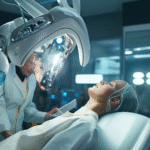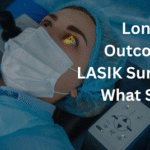Table of Contents
- What Is LASIK and Why Is Long-Term Data Important?
- Refractive Surgery Success Rates Over the Years
- Long-Term Benefits of LASIK
- Common Long-Term Side Effects of LASIK
- Factors That Influence Long-Term Results
- Enhancements and Retreatments: Are They Common?
- LASIK vs Other Refractive Surgeries: Long-Term Comparisons
- Conclusion
- Frequently Asked Questions
LASIK continues to stand out as one of the most popular ways to correct vision problems today. Millions worldwide have chosen this laser-based refractive surgery to reduce their dependence on glasses or contact lenses. But while many people know about LASIK’s quick recovery and short-term benefits, fewer understand how it holds up over years or more.
With more than two decades of data now available, we can look closely at how LASIK performs in the long run, covering its lasting success rates, common side effects, and what factors influence outcomes. This is especially helpful if you’re considering LASIK and want to understand the know-how of both its advantages and realistic expectations.
What Is LASIK and Why Is Long-Term Data Important?
LASIK is a laser vision correction procedure made to treat refractive errors like nearsightedness, farsightedness, and astigmatism. How does it work? It works by reshaping the cornea, and hence light focuses correctly on the retina, giving clearer vision. Unlike wearing glasses or contacts, LASIK directly adjusts the eye’s optical surface.
Over the past few decades, the number of people opting LASIK has gone up steadily. Many people are drawn to its fast recovery and the freedom from everyday eyewear. But as with any surgery, knowing how safe LASIK is in the long run and how stable results are helps patients make well-informed decisions.
Fortunately, extensive research has been done on LASIK long-term, confirming that it generally remains safe and effective for most people well into the future.
Refractive Surgery Success Rates Over the Years
Several large studies show that LASIK gives impressive long-term success. Satisfaction rates often exceed 95 percent, even when patients are surveyed 10 or more years after surgery. This high level of satisfaction comes from stable vision, reduced dependence on corrective lenses, and minimal serious complications.
It’s also worth noting that refractive surgery success rates can vary slightly. For example, based on age, the type of refractive error treated, and the technology used. Also, more modern systems, such as femtosecond lasers, provide finer precision that helps reduce complications. Overall, continuous improvements in laser platforms have made today’s procedures even more trustworthy compared to earlier days of refractive surgery.
If you are exploring the safety of LASIK or comparing refractive surgery success rates procedure to other options, these long-term findings are a reassuring sign of how far the field has come.
Long-Term Benefits of LASIK
For most patients, the major chunk of the benefit of LASIK is how well their distance vision holds up over the span of time. Many people continue to enjoy clear, stable eyesight 10 or even 20 years after their procedure. This greatly reduces daily reliance on glasses or contact lenses for most everyday activities.
There are also quality-of-life advantages. Patients often say they enjoy being able to wake up and see clearly right away without hunting for glasses. Many also feel more confident participating in sports, traveling, or simply dealing with day-to-day routines like reading clocks or signs.
Another important long-term benefit is convenience. Without the hassle of managing contact lenses or updating prescriptions very often, people often find that life simply becomes easier. All of these add up to why long-term satisfaction with LASIK remains so high.
Common Long-Term Side Effects of LASIK
Like any surgical procedure, LASIK does have risks that can persist or sometimes appear later on. Among the most discussed LASIK side effects long term are:
- Dry eyes: Up to 10 to 20 percent of patients may continue to notice mild dryness. This often improves over time and is managed with lubricating drops.
- Halos and glare: Some people see light rings or starbursts at night, especially around headlights. This was more common with older techniques but has reduced with modern technologies.
- Rare complications like ectasia: In a very small number of cases, the cornea can become slightly weaker, leading to a condition called ectasia that may require specialized contact lenses or further treatment.
- Minor vision regression: For some, eyes naturally shift a little over the years, which can bring back a mild prescription.
- Fluctuations with hormonal changes: Pregnancy or certain health conditions that affect hormones can sometimes cause subtle changes in vision after LASIK.
- Increased light sensitivity: A few patients report feeling slightly more sensitive to bright sunlight or glare over long periods.
Knowing about these LASIK surgery side effects long term helps patients make balanced decisions and also highlights the importance of choosing skilled surgeons and proper screening.
Factors That Influence Long-Term Results
A number of factors help determine how well your LASIK results hold up over the years:
- Patient age and original prescription: Younger patients with stable, moderate refractive errors generally have more predictable long-term outcomes.
- Technology used: Wavefront-guided or femtosecond laser procedures can provide more customized corrections, lowering the chance of imperfections.
- Post-op care: Following instructions, using prescribed drops, and attending check-ups play a big role in how well eyes heal and maintain clarity.
- Ongoing eye health: Conditions like dry eye or developing cataracts later in life can impact overall vision. Treating these early helps sustain LASIK results.
- Lifestyle factors: Excessive screen time, exposure to UV rays without protection, or not maintaining general eye hygiene can also influence how eyes feel years down the line.
- General health and medications: Some systemic diseases or medications can impact corneal stability or tear production over time.
Learning about these factors can help you and your doctor plan the best approach, including choosing advanced technologies like femtosecond lasers and addressing dry eyes if needed.
Enhancements and Retreatments: Are They Common?
Eyes naturally change with age, which means a mild prescription might return over time. When this happens, enhancement procedures can fine-tune your vision. These small touch-ups are generally quick, building on your previous LASIK treatment.
While most people never need a retreatment, studies suggest around 5 to 10 percent may choose a minor enhancement within 10 to 12 years. For others, an alternative procedure like PRK or even SMILE may be suggested if corneal thickness or shape has changed. These enhancements are usually straightforward and help keep vision sharp without returning fully to glasses or contacts.
Surgeons today design initial LASIK plans with enough residual corneal tissue to safely allow for these potential future adjustments.
LASIK vs Other Refractive Surgeries: Long-Term Comparisons
Many people also look into how LASIK compares with other options like SMILE, PRK, Contoura, or SILK. Each of these has its own benefits.
SMILE uses a smaller incision that can reduce dry eye risks, PRK is a good choice for thinner corneas since it doesn’t involve creating a flap, Contoura focuses on detailed corneal mapping for fine-tuned corrections, and SILK is an emerging option that combines several advantages of previous methods.
However, LASIK long-term remains one of the most studied and trusted procedures, with decades of solid data behind it. For most patients seeking fast recovery and proven results, LASIK continues to be a very strong choice.
Conclusion
Long-term studies show that LASIK remains both safe and highly effective for a large majority of patients. Most people enjoy stable, clear distance vision many years after their procedure, along with the freedom from daily glasses or contacts.
Though some side effects or adjustments are possible, these are often manageable with early screening, careful surgical planning, and proper follow-up. With today’s advanced technology, LASIK stands out as one of the most reliable ways to permanently correct vision.
If you’d like to explore whether LASIK surgery is a good fit for your eyes and lifestyle, a consultation can help you understand all your options in detail.





